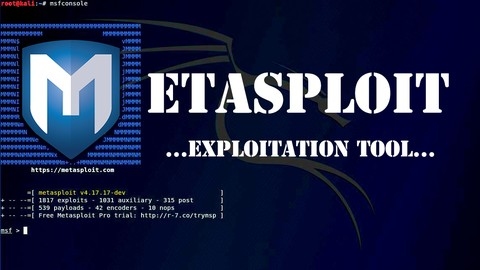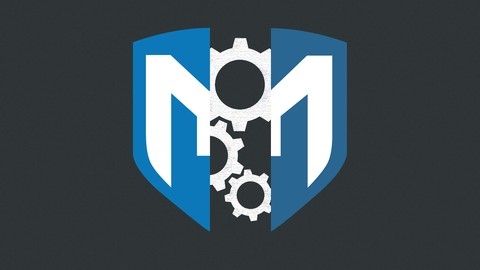Metasploit is a powerful penetration testing framework used by cybersecurity professionals to identify and exploit vulnerabilities in systems.
Learning Metasploit is crucial for anyone interested in ethical hacking, penetration testing, or cybersecurity, as it equips you with the knowledge and skills to assess and secure systems against real-world threats.
Finding a high-quality Metasploit course on Udemy that caters to your learning style and goals can be a daunting task.
You’re looking for a course that goes beyond theory, providing practical experience and hands-on projects to solidify your understanding.
We’ve got you covered!
For the best Metasploit course overall on Udemy, we recommend Metasploit Framework: Penetration Testing with Metasploit.
This course stands out for its comprehensive approach, covering everything from the fundamentals of penetration testing to advanced techniques like antivirus evasion and social engineering.
The instructor provides clear explanations and engaging lessons that make learning enjoyable and effective.
While this is our top pick, there are other great options available on Udemy for various skill levels and learning objectives.
Keep reading for our complete list of recommendations and find the perfect Metasploit course for your journey.
Metasploit Framework: Penetration Testing with Metasploit
You will start by learning the fundamentals of penetration testing, including its importance, types, and execution standards.
Next, you’ll set up a virtual lab environment using VirtualBox or VMWare, where you can practice ethical hacking techniques in a safe and controlled manner.
This includes installing Kali Linux, a popular operating system for penetration testing, and configuring various target systems like Metasploitable and Windows 7.
The course then dives deep into the Metasploit Framework (MSF), a powerful tool used by ethical hackers and penetration testers.
You’ll learn about its architecture, modules, interfaces like Armitage and MSFconsole, and how to use databases within MSF.
Additionally, you’ll explore the latest features introduced in Metasploit Framework 6.0.
Enumeration, a crucial step in penetration testing, is covered in detail.
You’ll learn how to use tools like Nmap for port scanning and enumerate various services like SMB, MySQL, FTP, SSH, HTTP, SNMP, and SMTP.
The course also teaches you how to integrate Shodan, a search engine for Internet-connected devices, with MSF.
Vulnerability scanning is another important aspect covered, with a focus on using Nessus Home and integrating it with MSF.
This will help you identify and exploit vulnerabilities more effectively.
The exploitation and gaining access section is where you’ll learn how to use MSF as an exploitation tool.
You’ll explore various exploits, including those for PHP CGI Argument Injection, MS17-010 EternalBlue SMB Remote Windows Kernel Pool Corruption, Java JMX Server Insecure Configuration Java Code Execution, and many more.
Post-exploitation is a critical phase, and the course covers it extensively using Meterpreter, a powerful payload in MSF.
You’ll learn how to use Meterpreter for tasks like privilege escalation, extracting password hashes, token impersonation, enabling remote desktop, packet sniffing, and pivoting.
Antivirus evasion and cleaning techniques are also covered, including using MSFvenom, encoders, custom executable templates, and custom payload generators.
You’ll learn how to clean events and security management logs, as well as deceive the file system using Timestomp.
Throughout the course, you’ll have opportunities to reinforce your learning with quizzes and practice exercises, ensuring you gain hands-on experience with the tools and techniques covered.
Practice Your First Penetration Test: Kali & Metasploit Lab
You’ll start by learning the fundamentals of pentesting, including the different types of pentests and the essential phases of the pentesting process.
From there, you’ll dive into Kali Linux, the powerful Debian-based distribution designed specifically for security auditing and penetration testing.
You’ll learn why Kali is so important and how to set up your own cyber security lab environment, complete with vulnerable virtual machines like Metasploitable and Windows 7.
Once your lab is ready, the course will guide you through working with Kali, familiarizing you with its desktop interface, menus, and essential tools.
You’ll learn how to update and upgrade Kali, as well as install VMware tools for seamless integration with your virtual machines.
The real fun begins when you start configuring your victims.
You’ll learn how to make Metasploitable and Windows 7 vulnerable, setting the stage for your pentesting adventures.
From there, you’ll dive into Nmap, the powerful network scanning tool.
You’ll learn different types of port scanning, service and version detection, and how to save your Nmap results for later analysis.
But the highlight of the course is undoubtedly the section on exploitation with Metasploit.
You’ll gain a deep understanding of Metasploit, the renowned exploitation framework, and its components like payloads, exploits, encoders, and post-modules.
You’ll even update Metasploit to ensure you have access to the latest modules.
With your newfound knowledge, you’ll exploit your first victim, gaining your first shell access.
You’ll practice essential commands like “id,” “ifconfig,” “pwd,” and “uname -a,” and learn how to background Metasploit sessions for continued hacking.
You’ll also delve into Windows hacking, learning advanced Windows scanning techniques and exploiting Windows 7.
And you’ll discover the power of Meterpreter, Metasploit’s advanced payload that provides you with a wealth of post-exploitation capabilities.
You’ll have a solid understanding of the importance of penetration testing in the information security world and hands-on experience with tools like Kali, Nmap, and Metasploit.
Most importantly, you’ll have hacked your first victims, giving you a taste of what it’s like to conduct real-world pentesting.
Real Ethical Hacking in 43 Hours: Certificated CSEH+CEH 2024
This course goes from ethical hacking fundamentals to advanced techniques like using Metasploit and the Volatility Framework.
You’ll start with an introduction to ethical hacking, learning about operating systems, file systems, and setting up a virtual lab environment.
The course then dives into networking concepts, cybersecurity basics, and passive information gathering techniques like OSINT.
As you progress, you’ll explore various storage media types and delve into Linux commands, permissions, and processes.
The curriculum also covers network security concepts, packet management systems, and using tools like Wireshark for network traffic analysis.
For the hands-on hacking portion, you’ll learn mobile hacking techniques for Android and iOS devices.
The course covers reconnaissance with Nmap, including advanced port scanning and firewall detection.
You’ll also gain insights into programming concepts and learn C++ for ethical hacking.
The SQL and Python sections equip you with essential skills for database manipulation and scripting.
And when it comes to Metasploit, you’ll master its fundamentals, from installation to information gathering, port scanning, and version detection.
Additionally, you’ll dive into the Volatility Framework, a powerful tool for memory forensics and malware analysis.
You’ll learn to analyze DLLs, perform network analysis, extract passwords, and even dump executables from memory.
Throughout the course, you’ll have opportunities to practice with hands-on exercises and projects, solidifying your understanding of the concepts covered.
Ethical Hacking with Metasploit: Exploit & Post Exploit
You’ll start by setting up virtual lab environments using VirtualBox or VMWare, ensuring you have a safe space to practice.
The course then dives into vulnerability scanning with Nessus, a popular tool for identifying weaknesses.
From there, you’ll learn about exploitation concepts and databases like CVE, exploring both manual techniques and frameworks like Metasploit.
The Metasploit section covers the msfconsole interface in-depth, teaching you how to search for and rank exploits, as well as using the powerful Meterpreter payload.
You’ll even learn techniques like Pass the Hash for hacking systems without exploiting vulnerabilities.
Post-exploitation is a major focus, covering persistence methods like backdoors and Meterpreter’s modules for maintaining access.
Pivoting, credential dumping with tools like Mimikatz, and gathering data are also included.
Password cracking gets dedicated attention, covering password hashes, cracking classifications, and tools like John The Ripper, Cain & Abel, and online crackers like HYDRA.
You’ll learn to crack Windows and Linux password hashes using different attack types.
Throughout, you’ll use essential ethical hacking tools like Nmap, Metasploit, and Burp for web app testing.
The course covers phishing, antivirus evasion, and touches on areas like Ruby coding for security.
With a balanced mix of theory and hands-on labs, this course aims to provide a comprehensive ethical hacking education with a focus on the powerful Metasploit framework.
Hacking and Penetration Testing from Scratch with METASPLOIT
You’ll start with an introduction to the powerful Metasploit framework, learning what it is and what you need to get started.
From there, you’ll dive deep into using Metasploit, working with its modules to conduct penetration tests and exploit vulnerabilities.
One key aspect is learning about different attack vectors that work, including database-oriented attacks.
This will give you practical skills for identifying and testing real-world vulnerabilities.
The course also covers taking control over compromised machines, an essential skill for any penetration tester.
For those interested in stealth techniques, there’s a section on creating and revealing rootkits and stealth applications.
You’ll even learn how to write your own shellcode, a valuable offensive security skill.
Throughout the course, you’ll get hands-on experience with Metasploit in a controlled environment.
The practical focus ensures you develop the skills needed to use this powerful tool effectively for penetration testing and red teaming engagements.
With downloadable notes and bonus content, you’ll have plenty of resources to reinforce your learning.
Ethical Hacking & Penetration Testing with Metasploit
The course covers ethical hacking and penetration testing using the powerful Metasploit framework.
You’ll start by learning the fundamentals of ethical hacking, including legal issues, testing standards, and setting up virtual lab environments.
The course then dives into networking concepts like protocols, addressing, and packet analysis with tools like Wireshark.
A major part of the course focuses on reconnaissance techniques to gather information about targets using search engines, Shodan, and other tools.
You’ll learn how to scan networks and websites for vulnerabilities using Nmap, Nessus, and various scanning methods.
The course provides in-depth training on using Metasploit for exploitation, covering its interfaces, modules, databases, and integration with other tools.
You’ll learn to exploit vulnerabilities, gain access to systems, and perform post-exploitation activities like maintaining persistence and evading antivirus software.
Additionally, the course covers creating malicious files, password cracking techniques, web application hacking with tools like Burp Suite, and advanced topics like bypassing security controls and pivoting through compromised systems.
Ethical Hacking: Metasploit
The course starts with an introduction, ensuring you have a solid foundation before diving into the core concepts.
You’ll learn about Metasploit itself, a powerful tool for penetration testing and vulnerability assessment.
From there, you’ll explore Metasploit options, giving you the ability to customize and fine-tune your approach.
Portscanners are essential for identifying open ports and potential entry points, and you’ll learn how to use them effectively.
Brute forcing techniques will also be covered, allowing you to crack passwords and gain unauthorized access.
One of the course’s highlights is learning how to search for and exploit vulnerabilities in Windows 2k systems.
This practical knowledge is invaluable for ethical hacking and security testing.
Additionally, you’ll delve into msfvenom, a tool for generating payloads, and learn how to create and use reverse shells for remote access.
The course provides comprehensive notes on reverse shells, ensuring you have a thorough understanding of this crucial technique.
Ethical Hacking with Metasploit the Penetration testing Tool
The course starts by introducing you to Metasploit, a powerful penetration testing tool.
You’ll learn how to set up a perfect lab environment for exploitation, including installing VMware for network connectivity and Kali Linux OS.
Once you have the setup ready, you’ll dive into creating payloads using msfvenom and sending them to the server.
The real fun begins when you start exploiting vulnerabilities in various operating systems like Windows XP, Windows 7, and Windows 10 using these payloads.
You’ll also learn how to use simple Metasploit commands to gather system information, monitor user activity (including key-logging and webcam spying), and execute shell commands.
The course covers essential networking commands and techniques like enumerating information using WMIC.
Information gathering is a crucial aspect of penetration testing, and this course equips you with the skills to extract valuable data from the target machine.
You’ll learn how to retrieve the product key, directory permissions, USB history, installed applications, and even LNK files of users.
The course doesn’t stop at client-side exploitation.
You’ll also learn how to perform server-side port scanning for protocols like FTP, SSH, TELNET, and SMTP (email).
This knowledge will be invaluable when conducting web exploitation tasks.
Speaking of web exploitation, the course dives deep into web servers and websites.
You’ll learn how to execute commands and exploit web servers, as well as techniques for HTTP brute-forcing directories and traversing directory paths.
Learn the Metasploit Framework inside out
You’ll start with setting up your environment and getting familiar with the Metasploit filesystem and modules.
The course then dives into Metasploit fundamentals, teaching you how to use msfconsole and its core commands, exploiting vulnerabilities, generating payloads with msfvenom, and working with resource scripts and databases.
Information gathering is a crucial aspect covered in-depth, including port scanning with db_nmap, manual information gathering, and vulnerability assessment with the Nessus community edition.
You’ll learn how to scan web applications with auxiliary modules and exploit various services like Tomcat, ManageEngine, ElasticSearch, Ruby on Rails, WebDav, and Wordpress on WAMP.
The course even covers exploiting port 445 with psexec and the infamous Eternal Blue vulnerability.
Social engineering techniques are also covered, including generating payloads, trojanizing executables with msfvenom, and using Beef-XSS with Metasploit.
Antivirus evasion is a critical skill, and you’ll learn how to improve your success rate with the Veil Framework.
Post-exploitation is a significant part of the course, covering monitoring user activities, enabling Remote Desktop, privilege escalation, cracking password hashes, and creating persistent Meterpreter backdoors.
You’ll also learn how to clean up after yourself, leaving no traces behind.
With this course, you will learn the Metasploit Framework inside out, from the PTES to advanced exploitation techniques, social engineering, antivirus evasion, and post-exploitation activities.
The course is comprehensive, practical, and hands-on, ensuring you gain the skills to become a proficient Metasploit user.
Penetration Testing with Metasploit Ethical hacking stream
You’ll start with an introduction to penetration testing and the Metasploit framework, learning about auxiliary scanning, exploits, and payloads.
The course dives deep into Metasploit, covering the msfconsole, msfcli, and Armitage interfaces.
You’ll learn how to work with Meterpreter, a powerful payload that provides extensive post-exploitation capabilities.
From core commands to file operations, user interfaces, system commands, and networking, you’ll master Meterpreter’s functionalities.
Client-side attacks are also covered, including msfpayload, msfencode, and msfvenom for creating binary payloads.
You’ll learn to exploit vulnerabilities in MS Office documents and PDFs, as well as set up persistent backdoors and exploit software misconfigurations, even on fully patched machines.
Browser-based exploitation is a key focus, with hands-on experience in installing and configuring BeEF (Browser Exploitation Framework) and integrating it with Metasploit modules.
Social engineering techniques like tabnabbing and web-jacking are also explored.
The course covers advanced topics like evading antivirus detection using the Veil framework and integrating Veil scripts with Armitage for stealthy exploitation.
You’ll learn to create customized PowerShell scripts for attacking target machines.
Practical labs are included, guiding you through setting up Kali Linux and configuring third-party vulnerable test beds for realistic practice scenarios.
You’ll also learn to use Nessus for vulnerability scanning and exploit identified vulnerabilities using the Nessus report.
With a hands-on approach and a focus on real-world scenarios, you’ll gain the skills needed to conduct effective penetration tests and secure systems.










